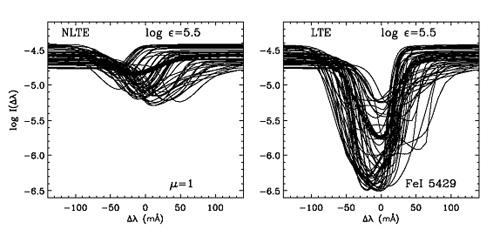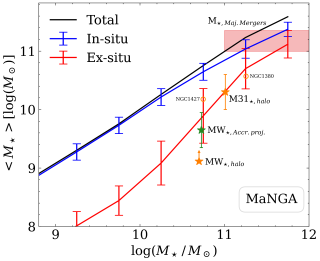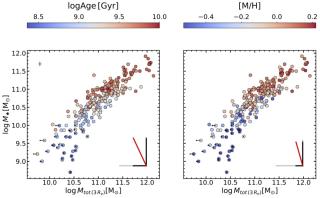Intensity profiles of an iron line calculated in a 3D hydrodynamical model of the atmosphere of a metal-poor star, assuming LTE (right panel) and without assuming LTE (left panel). The resulting average profile in each case is that given by thickest line.
Advertised on
References
The Astrophysical Journal, 618:939-952, 2005 January 10
The abundances of oxygen and iron in metal-poor stars have been determined through non-LTE radiative transfer simulations in three-dimensional (3D) hydrodynamical models of their atmospheres. The performing of this type of calculations required to develop first very efficient numerical methods and computer programs. Taking into account that the atmospheres of the stars are 3D systems and the impact of non-LTE effects leads to very significant changes in the derived chemical abundances. It has been concluded that the metalicity of some metal-poor stars could be significantly larger than previously thought.
More info
THE IMPACT OF NON-LTE EFFECTS AND GRANULATION INHOMOGENEITIES ON THE DERIVED IRON AND OXYGEN ABUNDANCES IN METAL-POOR HALO STARS
This paper presents the results of a detailed theoretical investigation of the impact of non-LTE (NLTE) effects and of granulation inhomogeneities on the derived iron and oxygen abundances in the metal-poor halo subgiant HD 140283. Our analysis is based on both the ‘‘classical’’ one-dimensional stellar atmosphere models and on the new generation of three-dimensional hydrodynamic models. The NLTE calculations presented here have been carried out without inelastic collisions with neutral hydrogen atoms. We find that if NLTE effects are taken into account when synthesizing the Fe i spectrum in both types of atmospheric models, then the derived iron abundance turns out to be very similar in both cases. The emergent spectral line profiles in both models are very much weaker in NLTE than in LTE because the UV overionization mechanism produces a very strong underpopulation of the Fe i levels, in particular in the granular regions of the three-dimensional model. As a result, the NLTE effects on the derived iron abundance are very important, amounting to 0.9 and to 0.6 dex in the three- and one-dimensional cases, respectively. On the other hand, we find that NLTE and three-dimensional effects have to be taken into account for a reliable determination of the iron abundance from weak Fe ii lines, because the significant overexcitation of their upper levels in the granular regions tend to produce emission features. As a result, such Fe ii lines are weaker than in LTE and the abundance correction amounts to 0.4 dex for the three-dimensional case. We also derive the oxygen-to-iron abundance ratio in the metal-poor star HD 140283 by using the O i triplet at 7772–7775 8 and the forbidden [O i] line at 6300 8. Our results for the oxygen abundance confirm the values reported in some recent investigations. While the oxygen abundance derived from the O i IR triplet is not very sensitive to the presence of granulation inhomogeneities, such three-dimensional effects amount to 0.2 dex for the [O i] line. The NLTE abundance correction for the O i IR triplet turns out to be 0.2 dex, approximately. Interestingly, when both NLTE and three-dimensional effects are taken into account there still remain significant discrepancies in the iron abundances derived from Fe i and Fe ii lines, as well as in the oxygen abundances inferred from the O i and [O i] lines. We conclude that the discrepancies could be due to uncertainties in the stellar parameters of this metal-poor star. We argue that adopting TeA 5600 K (instead of TeA 5700 K) and ½Fe=H2:0 (instead of ½Fe=H 2:5) substantially reduces the discrepancies in the abundances of iron and oxygen inferred from several spectral lines. Under such circumstances, we find ½O=Fe 0:5 at ½Fe=H¼2. Obviously, our tentative conclusion that the metallicity of this type of metal-poor star is significantly larger than previously thought may have far-reaching implications in stellar astrophysics.
Year
2005



